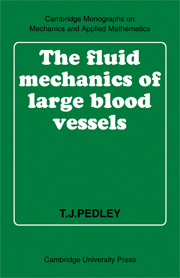Book contents
- Frontmatter
- Contents
- Preface
- 1 Physiological introduction
- 2 Propagation of the pressure pulse
- 3 Flow patterns and wall shear stress in arteries
- 4 Flow patterns and wall shear stress in arteries
- 5 Flow patterns and wall shear stress in arteries
- 6 Flow in collapsible tubes
- Appendix: Analysis of a hot-film anemometer
- References
- Index
1 - Physiological introduction
Published online by Cambridge University Press: 05 March 2012
- Frontmatter
- Contents
- Preface
- 1 Physiological introduction
- 2 Propagation of the pressure pulse
- 3 Flow patterns and wall shear stress in arteries
- 4 Flow patterns and wall shear stress in arteries
- 5 Flow patterns and wall shear stress in arteries
- 6 Flow in collapsible tubes
- Appendix: Analysis of a hot-film anemometer
- References
- Index
Summary
The overall arrangement of the mammalian cardiovascular system can be summarised briefly as follows. The heart is composed of four chambers arranged in two pairs. The thin-walled atrium on each side is connected through a valved orifice to a thick-walled muscular ventricle; each ventricle connects in turn to a major distributing artery, the mouth of which is again guarded by a valve. The left ventricle is the thicker and leads to the aorta (diameter about 2.5 cm in man), through which oxygenated blood is distributed to the tissues of the body. Large arteries branch off the aorta, smaller ones branch off them, and so on for many subdivisions; the number of branchings along any pathway depends on the particular organ being supplied. The final subdivisions of the arterial tree are the arterioles, which have very muscular walls and internal diameters in the range 30–100 μm. These vessels give rise to the capillaries (diameters down to 4 or 5 μm) across the walls of which the principal exchange of fluids and metabolites between blood and the tissues takes place. The blood passes from the capillaries into the smallest veins (venules) and thence into a converging system of increasingly larger veins, finally merging into the superior and inferior venae cavae which join directly to the right atrium of the heart. (An exception to this pattern is the circulation in the heart muscle itself, which drains directly into the right atrium.)
- Type
- Chapter
- Information
- The Fluid Mechanics of Large Blood Vessels , pp. 1 - 71Publisher: Cambridge University PressPrint publication year: 1980



